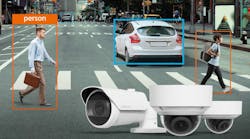Will this battle for pixel supremacy ever end? Have we finally reached the point where we are willing to concede that packing another million or so pixels onto a sensor really isn’t going to provide any discernable advantage for security professionals? If you attended any of the major tradeshows over the last year the answer would be a resounding NO! Despite the limitations of a niche offering, manufacturers still seem to equate more pixels to better image quality and so the one-upmanship continues.
But what we should actually be talking about is Image Usability –how well an image meets the operational requirements of a given scene. Adding more pixels only affects resolution, often at the expense of other factors that drive image usability such as color rendition, frame rate, and aspect ratio. This brings us to an all important distinction between megapixel and Ultra High Definition Standard (UHDTV) more commonly referred to as 4K.
While people often think of the two technologies as interchangeable, they are not. In fact, when you compare 4K cameras to their megapixel cousins, the only thing they have in common is the resolution. Only 4K adheres to a rigorous standard which enable it to deliver the following:
- An 8-megapixel resolution that enables security professionals to achieve more pixels on target with wider fields of view
- A broader palette to render colors more accurately so that security is better able to discern the true hue of clothing, vehicles and other objects in the field of view
- A frame rate of 30 frames per second (FPS) so security won’t miss crucial details in action sequences that are essential for complete situational awareness
- A 16:9 aspect ratio so security can achieve a broader coverage of the scene or turn the aspect ratio into corridor view (9:16) to monitor activity in long hallways
Megapixel cameras, on the other hand, are not bound by standards. And without standards, megapixel cameras often fall short on the other aspects of Image Usability.
So which technology will ultimately be able to go the distance? Let’s have them duke it out in the Image Usability ring and you can judge for yourself.
Round 1: Does Megapixel Win points on Resolution?
4K maxes out at eight million pixels, which appears to be the only punch megapixel can land since megapixel can scale well beyond that range. But is that really an advantage?
As mentioned earlier, the operational requirement of a scene is defined by detecting, recognizing, and/or identifying a person or object within the scene. It is generally accepted in the security industry that 80 pixels across the width of a person’s face provides sufficient coverage for a positive identification. The value of increasing the resolution is two-fold: you can maintain pixel density on the target area and you can use a wider angle lens to cover a broader area. In essence each camera can cover a wider field of view. In theory, this means that security practitioners can deploy fewer cameras to cover the same area while maintaining the operational requirement.
So megapixel might have a longer reach when it comes to resolution. But truly, how often does a need arise for more than 8 million pixels? In my opinion, this lack of installation opportunity makes megapixel a knockout in niche situations only.
Round 2: Does 4K Score a Knock-Down with Color Fidelity?
Have you ever seen video on a display that just didn’t look the same as it did with the naked eye? Color rendition is not always easy for cameras to reproduce accurately. With security, the color of a car or an article of clothing has real forensic significance. It’s one thing if the Baltimore Ravens uniforms appear black instead of deep purple but entirely different if the wrong suspect is apprehended for the same color disparity.
With a broader palette to work from, 4K cameras generate images that accurately depict the tonal values of people, objects, and backgrounds in a scene. Paired with corresponding 4K television displays, the color rendition provides accurate representation in both real-time and post-incident forensic review.
Speaking of displays, if the display’s resolution does not exceed or meet the resolution of the camera then what have you really gained? Most cable networks broadcast both HD and standard definition versions of the same programming. Try switching back and forth the next time you are watching your favorite sport and look at the crowd versus the athletes. Are you missing some details? Of course you are. The same thing happens when you view higher resolution surveillance images on displays that don’t match the camera’s resolution.
With something as important as color rendition, 4K wins this round handedly.
Round 3: Does 4K Land a Flurry of Jabs for Situational Awareness?
A big factor contributing to situational awareness is the number of frame per second that a camera is able to deliver. The eye perceives full motion video at around 16 FPS but most security cameras can deliver 30 FPS. In fact, the HDTV standard defines a minimum frame rate of 30 FPS. And here’s where 4K’s speed dazzles its opponent. Imagine reviewing a recording of an employee caught stealing money out of a cash register drawer. If you watched that event unfold at five versus 30 FPS, you could be missing a lot of the action. Most likely the thief walked away with an additional $20 in their pocket and you did not have any objective forensic evidence to prove what you were pretty sure was happening between frames.
Megapixel cameras often come with frame rate limitations that are far lower than the 30 FPS you can achieve with 4K. This limitation in frame rate makes them good for general surveillance applications at best leaving 4K a clear winner where seamless situational awareness is a requirement.
Round 4: Does 4K Show Surprising Footwork in Aspect Ratio?
The consumer electronics adoption of wide-screen TVs eventually became the defacto standard for displays in the security industry as well. Now that 4K TVs are the new rage in the consumer electronics and broadcast industries, the security industry will inevitably follow suit.
While the wide-screen format (16:9) has done much to improve surveillance coverage, there’s another more important application of aspect ratio that is gaining momentum in the security industry. This involves reorienting the camera so that the image represents a 9:16 aspect ratio. Think of hallways, warehouses with high shelves, or even long city blocks in an urban environment. By changing the aspect ratio 16:9 to 9:16, we are able to deliver more pixels in the area of the image where an event will most likely occur. It’s the difference between having more pixels on the walls of a hallway versus on the person walking down it.
With proliferation of newer displays, 4K with a flexible aspect ratio of 16:9 and 9:16 clearly delivers the knockout punch over megapixel
And the Winner Is . . .
So should you always go for 4K over megapixel? The answer really depends on the operational requirements you are looking to achieve and the corresponding scene characteristics with which you have to work. There are circumstances where a 20-megapixel camera at a much lower frame rate can outperform its 4K cousin – such as in monitoring larger swathes of land or getting a general overview of a stadium. The seasoned security integrator will evaluate the needs and make a recommendation that fits the customer’s requirements.
Comparison of key parameters for 4K and megapixel cameras are summarized in the following table:
|
Type |
Resolution |
Pixels |
Aspect Ratio |
Mbit/s |
Storage (28 days) |
|
3 megapixels |
2048x1536 |
3.145.728 |
4:3 |
5.71 |
1.73 TB |
|
5 megapixels |
2560x1920 |
4.915.200 |
4:3 |
8.04 |
2.43 TB |
|
4K |
3840x2160 |
8.294.400 |
16:9 |
13.56 |
4.1 TB |
As with any choice between camera technologies, there are always tradeoffs.
High resolution vs. storage and bandwidth consumption: Foremost is resolution because it has a direct correlation between bandwidth demands and storage requirements. The higher the image resolution the more data is generated to be stored and the more bandwidth will be consumed. Advances in compression algorithms such as H.264 and the newer High Efficiency Video Coding (HEVC), also known as H.265 help mitigate this issue by significantly reducing the files size of the images without degrading their usability or quality.
High resolution vs. light sensitivity and dynamic range: Higher resolutions reduce light sensitivity due to the smaller pixel size that is implemented in these cameras. These smaller pixels require higher light levels to activate and thus are not as effective in lower light situations. The same issue plays out in the dynamic range of the camera which measures the cameras ability to capture both the light and dark areas of a scene.
Despite these limitations, both 4K and megapixel cameras provide real value for security practitioners who need to monitor and record large areas. Their higher resolution allows wider field of views while still maintaining the appropriate pixels on target to meet operational requirements. With 4K you get the added benefit of a standard that defines expectations up front and produces more usable surveillance footage.
About the author:
James Marcella has been a technologist in the security and IT industries for nearly two decades. He is currently the Director of Technical Services for Axis Communications.


